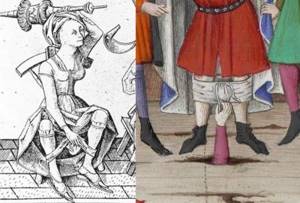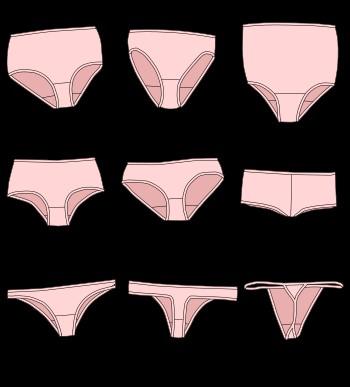Rating: 5 / 5
In ancient times, only men wore underwear, if, of course, a loincloth can be called that way: this detail protected the reproductive organs, and procreation played a significant role in the life of the tribe. But representatives of the fair sex began to wear underwear much later. Knickers and “bust supports” were finally recognized in Europe only in the 19th century. In Russia, the fate of women's underwear turned out to be closely connected with the history of the country itself.
Wasp waist
During the time of Peter I, as you know, everything German was in fashion, including clothes. And in Germany then, as well as throughout Europe, the canons established by Catherine de Medici were in effect, requiring that a woman’s waist be no more than 35 cm. In connection with this, obese women had some difficulties. The corset solved their problems. Although Peter I gave preference to portly beauties, after a trip to Europe he strongly recommended that Russian court ladies follow European fashion. Why did he personally bring this detail of the women's toilet? The Russian Tsar did not take into account one thing: in Europe, girls from childhood were taught to wear corsets, and Russian young ladies of a magnificent physique could hardly tolerate this “armor”, in which it was difficult for them not only to dance at balls, but even to breathe. The woman could not put on the corset on her own. The maid had to work for several hours to tighten the lacing and turn the plump into a reed. At the same time, the fashion victim was forced to hold on to a support so as not to fall. Later, women began to wear tight leotards under their dresses. At the same time, the underwear of decent ladies had to be exclusively white or flesh-colored. Other colors were considered indecent. However, the leotard could not emphasize the waist and chest. Therefore, the corset returned to the women's wardrobe.
How to wear pantaloons correctly?
Many fashionistas wonder how to wear women's pantaloons:
- When you decide to replenish your wardrobe, it is important to purchase shorts exclusively by size. They should not cut into the body or puff up.
- If models are worn as underwear, then they should not peek out from under outerwear. Therefore, they should be 10 cm shorter than the hem of the skirt or dress.
- In 2011, designers Dominic Dolce and Stefan Gabbana offered their version of lingerie. They turned it into shorts that highlight the hips and visually lengthen the legs. From now on, they can be seen on celebrities who do not hesitate to wear pantaloon shorts to social events.
- Lingerie is worn with jackets, T-shirts, T-shirts and corsets. The images are different, but feminine.
- To correctly combine products, you must first understand why they are being purchased. They can be worn to yoga classes, ballet classes or everyday walks. Cotton and knitted models serve as home clothes that are comfortable and pleasant. They do not restrict movement and will last a long time.
- Certain women's long styles are appropriate for a walk if worn with a jacket or long tunic.
Item for home
Of course, such a war with nature could not but bring harm. In 1895, Wilhelm Roentgen discovered radiation, which was called x-rays. The first thing the scientist did was take pictures of his wife’s chest. He was shocked to see the ribs and internal organs deformed by the corset. After this discovery, the scientific world began to demand a ban on corsets. However, women's breasts still needed to be emphasized somehow. And in 1903, the doctor Ghosh Capo proposed dividing the corset into two parts: for the bust and for the waist. Later, the second began to serve as a garter belt. The first so-called “backless bra” was made by the American Mary Jacobs in 1914 - from tailor’s ribbons and two handkerchiefs. She immediately patented her invention under the name Caresse Crosby. At first, her bras were not a success. As a result, she sold the patent to a corsetry company for $1,500, and over 30 years it earned $15 million from bras. In Russia, bras, or “bust holders” as they were called, appeared in 1910: they were brought and sold by a certain industrialist named Abramson. It is noteworthy that on the labels intimate goods were modestly designated as “things for the home.” At the same time, it was produced in three sizes and cost 4 rubles.
Rolled up pants
The word “panties” was formed from a combination of two French words: “culotte” and “trousse”, which literally meant “rolled up pants”. The introduction of Russian women to this detail of the ladies' lower toilet began in the middle of the 19th century - with the wearing of pantaloons. Before that, the cold areas were protected by numerous skirts and an undershirt tied at the bottom. True, in the 17th-18th centuries, on critical days, women wore “private ports”, reminiscent of long panties made of thick fabric. The first women's pantaloons looked more like a skirt sewn at the bottom. At first, their cut was simple, only the cuffs were a little decorated with lace. At the same time, the trouser legs were not sewn together so that the lady could relieve herself without taking off her pantaloons. For it was very difficult to do this without outside help, because from above they were tightly pressed to the body by a corset. When pantaloons finally took on their true form, older ladies refused to wear them, considering them part of a man's wardrobe. But then someone, just in time, remembered the same Catherine de Medici, who rode horseback in men’s pants. And a convincing argument in favor of pantaloons was found. Panties in our usual form appeared at the beginning of the 20th century. True, due to their high cost, only wealthy ladies could buy them...
Women's panties in Rus'
All over the world, women did not know the purpose of this attribute and wore multi-layered long skirts.

Seamstresses sewed linen for the queen or countess. And peasant women wore homespun dresses.
However, women adapted to the necessary conditions and managed to “create” something similar to cowards. Reliable sources claim that peasant women used a petticoat, tying the ends of the hem. There was a need for this on “certain days.” Opponents of this knowledge say the opposite. In those days, it was difficult to weave clothes and women took care of them. It was unacceptable to “get dirty” the skirt.
In winter, woolen stockings alone did not protect against the cold. Soon, rich women began to use these modified skirts, decorating them with additional fabrics to their taste. It can be considered that practical women of the lower strata became the inventors of panties. The fabric used was not of the best quality, and not all women could afford it.

In England, women had already adapted to sewing these ends of the “petticoat” together, and this is how the first pantaloons appeared . Over time, they began to be shortened, along the length of the skirt, which, with fashion innovations, rapidly “grew” upward.
A little later, the famous Coco Chanel made the “life” of panties easier, making the underwear fabric more practical. Women began to wear panties made of cotton and linen; in rare cases, lace and ruffles were used.
Keeping up with history
In the 1930s, ideas of gender equality took root in Soviet society. In this connection, ruffles, lace and other delights are a thing of the past. The assortment of underwear has become scarce. In stores you could find four types of long johns, cotton shirts and briefs: white, black, blue. As for bras, the industry produced only one model in three sizes: 1, 2 and 3. Women who did not fall under these standards got out as best they could. In the 1950s there were six sizes, and by the 1970s there were nine. After the Great Patriotic War, Soviet women were able to appreciate the variety of models and colors of captured underwear. Another piece of underwear - the slip - quickly gained popularity. Some were not even embarrassed to go out in it, not seeing anything shameful in it. In the 1970s, after Furtseva’s words that “every Soviet woman has the right to a quality bra,” the assortment in stores increased. But diversity and grace were still a long way off. There is a known case when the Soviet model Leka Mironova, who participated in a show at World Fashion Week in Moscow, completely refused to wear a bra, just so that her Western colleagues would not see this Soviet product. German and Czech underwear appeared in the capital only 10 years later. And then it could be bought either in shops through connections, or from speculators, and for a lot of money. But, according to reviews of Soviet women, it was worth it. Fortunately, all these horrors are behind us: today you don’t have to choke in a huge line for underwear or buy panties from a speculator in the gateway, barely having time to assess their size. Modern stores are full of beautiful sets of underwear - for every taste and budget.
Yves Montand and Soviet trousers
In 1963, the famous actor and chansonnier Yves Montand came to the USSR on tour. When leaving back, he bought a whole collection of Soviet women's underwear. In France, he organized an exhibition, the visitors of which had a lot of fun looking at the fleece trousers and ridiculous panties! colors and bras without undercuts.
types of women's panties
When working with clients, the question often arises about the types of women's panties, and often the information does not match... it is very convenient to have a picture or description on hand, or better yet an entire article like the one below, so as not to indulge in spatial explanations of how slips differ from thongs
Varieties
There are three main types of women's panties in the world - maxi, midi and mini, from a closed neckline to the most open, respectively. Maxi panties generally come with a waistline that drops to the hips. There are different types of cuts in these categories:

1 - Slip 2 - Corset briefs 3 - Corrective briefs 4 - Hipster or low-cut culottes 5 - Pageslip 6 - Boyshorts or shorts 7 - Tanga 8 - Tong 9 - J-string
Mini
- Pagenslip (from the English Pagenslip) - high panties with a straight cut for the legs. Usually used for bikinis.
- Vikini (from the English v-kini) - briefs with a high side stripe, a deep cut in the front and a narrowing in the back.
- Thongs (from the English string) are briefs, the front part of which is a triangle, and the back part is a strip of fabric or ribbon passing between the buttocks.
There are four types of String panties: T-string (from the English T-string); J-string (from English G-string); V-string (from the English V-string); C-string (from English C-string)/
- Tong (from the English thong) are panties formed by combining the String and Vikini silhouettes in a minimal version. Thongs differ from String panties by a characteristic lowering of the waistline in the center in the front, sometimes even in a V-shape.
- Devan-derer (from the English devan-derer) - panties that have the narrowest length in front and back.
- Bikini (from the English bikini) - briefs with a very low waistline, the elastic is located almost on the hips. The front and back are theoretically made up of two triangles of fabric, but in practice they are difficult to notice, so tiny are the triangles.
Midi
- Tanga (from the English tanga) are panties consisting of two triangles with a very narrow connecting strip on the hips in the form of a strip of fabric or elastic.
- Slip (from the French slip) are traditional briefs that cover the buttocks, with a cutout to the middle of the thigh. The elastic band can be at waist level or can go down to mid-thigh.
- Culotte (from the French culotte) - briefs with a full-length back panel and a low hip cut. There is also an understated version of the culotte - hipster.
Maxi
- Briefs-shorts or Boyshorts (from the English boyshorts) are a model of panties in which the front and side parts are the same length.
- Belt panties - panties with removable stocking pages and reinforcing parts.
- Corset panties are panties with a strong shaping effect, which is achieved with the help of seals in the area of problem areas.
- Swim trunks are swim briefs, mostly made from quick-drying, elastic synthetic fabrics.
- Knickers (from Italian pantaloni) are a corsetry product with a high waistline. May have seals in problem areas.
In British England, as well as other places such as Great Britain, Ireland, South Africa, India, and sometimes other countries such as Australia and New Zealand, knickers are often called "knickers". The term "knickers" is not commonly used in the US and Canada, where the term "knickers" usually refers to a utility item.









